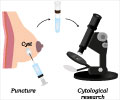Learn about the disparities in immunotherapy access for Black patients with triple-negative breast cancer (TNBC) compared to white patients.

‘Black patients with triple-negative #breast_cancer (TNBC) receive #immunotherapy at lower rates than white patients. #racialdisparity #medindia’





Many of the molecularly targeted medicines used to treat other subtypes of breast cancer are not available to patients with TNBC due to the lack of these receptors.TNBC grows more aggressively most of the time and is therefore more difficult to treat, leading to worse outcomes. This is because no medication has been specifically developed to control TNBC.
The FDA approved pembrolizumab (Keytruda), an immunotherapy, in conjunction with chemotherapy for patients with PD-L1 positive, metastatic TNBC in 2020 and for patients with high-risk, early-stage TNBC in 2021.
Immunotherapy has recently become a part of the treatment landscape for triple negative breast cancer (TNBC). These approvals were the result of encouraging clinical trial results (1✔ ✔Trusted Source
Black Patients With Triple-negative Breast Cancer May Be Less Likely to Receive Immunotherapy Than White Patients
Go to source).
Atezolizumab (Tecentriq), another immunotherapy, was first given accelerated approval in 2019 to treat advanced PD-L1-positive TNBC; however, the approval was withdrawn in 2021.
Advertisement
Racial Disparities in Immunotherapy Access
“Since 2019, immunotherapy has become a standard treatment option for TNBC, but it is mostly unknown whether there are racial/ethnic disparities in who receives immunotherapy or in the outcomes for early-stage and metastatic TNBC,” said Freeman.“Understanding these elements is key to developing strategies or interventions to ensure equitable access to immunotherapy and to mitigate the known racial/ethnic disparities in TNBC outcomes.”
Advertisement
They found that the percentage of patients who received immunotherapy increased from 2017 to 2021 as follows:
- From 4.2% to 48.0% among patients with early-stage TNBC
- From 5.3% to 33.1% among patients with metastatic TNBC
Role of Socioeconomic Status in Treatment Access
This translated to an 11% lower rate of immunotherapy receipt for Black patients after adjusting for clinical factors. The difference, however, was no longer statistically significant once the researchers further accounted for socioeconomic differences between the populations.Freeman noted that this suggests that socioeconomic factors might be the main barriers to immunotherapy access for Black patients with early-stage TNBC. Still, he acknowledged that the data represent an early snapshot since immunotherapy for early-stage TNBC was not approved until mid-2021.
Of the patients with metastatic TNBC who underwent chemotherapy between 2019 and 2021, 28.1% of Black patients and 35.5% of white patients received immunotherapy.
After adjusting for clinical and socioeconomic factors, Black patients remained 37% less likely to have received immunotherapy than white patients, a statistically significant difference.
Among those who received immunotherapy, rates of pathologic complete responses and overall survival were similar between Black and white patients with early-stage TNBC and metastatic TNBC, respectively.
“A key finding of our study is that Black patients with metastatic TNBC were less likely than white patients to have received immunotherapy, but when they did receive immunotherapy, they had a similar overall survival rate as white patients,” said Freeman.
“This tells us that receiving immunotherapy may help mitigate racial differences in the survival of patients with metastatic TNBC.”
Factors found to be associated with a lower likelihood of immunotherapy receipt in patients with TNBC were being enrolled in Medicare (16% lower rate than those with private insurance) and receiving care through a comprehensive community program (20% to 21% lower rate than those at academic/research centers).
“Expanding insurance coverage, lowering health care costs, and improving treatment distribution and access, particularly for those programs serving socioeconomically disadvantaged communities, are needed to move toward equitable access to immunotherapy across different populations with TNBC,” said Freeman.
Since PD-L1 expression is a prerequisite for pembrolizumab treatment for metastatic TNBC, Howard noted that additional research is needed to understand whether there are differences in tumor PD-L1 expression between Black and white patients that could have contributed to the observed disparities in immunotherapy receipt.
Limitations of the study included its retrospective design, the lack of information in the National Cancer Database about the immunotherapy regimens patients received, and the lack of information about PD-L1 tumor expression in different populations.
Reference:
- Black Patients With Triple-negative Breast Cancer May Be Less Likely to Receive Immunotherapy Than White Patients- (https:www.aacr.org/about-the-aacr/newsroom/news-releases/black-patients-with-triple-negative-breast-cancer-may-be-less-likely-to-receive-immunotherapy-than-white-patients/)
Source-Eurekalert











